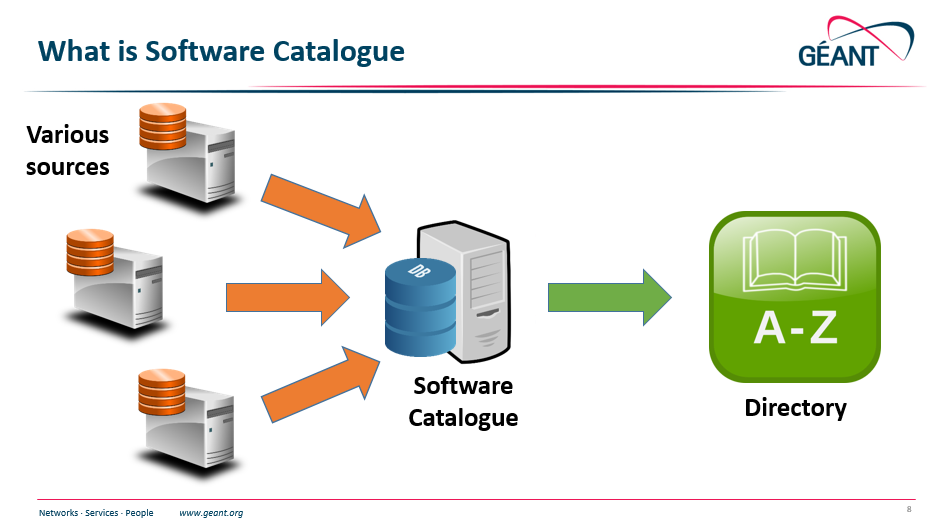Introduction
GÉANT Software Catalogue is an up-to-date repository of information about software development projects and teams. The tool facilitates and supports the software engineering community in various processes that require knowledge on software development efforts.
More than 4 years ago, in February 2019, the Software Catalogue was launched and keeps working on the long term mission of building and sharing the "big picture" of GEANT software development efforts. The SC does this in an automated way by exploring projects' resources like Git, JIRA, GitHub, GitLab and many others.
SC may be compared to other available directories like, for example, Apache Projects Directory.
 Image Added
Image Added
Example use cases for the catalogue
| Advanced Tables - Table Plus |
|---|
| border | 1 |
|---|
| rowStyles | background:lightyellow,background: lightyellow |
|---|
| heading | 0 |
|---|
|
| As a software engineer I can search for |
|
...
| teams doing a related work so that I can start cooperating. | As a |
|
...
...
| I can get an overview of project characteristics so that I can better plan training activities. | As a maintainer I can recognize actual community in my project. | | As developer of a |
|
...
| single microservice I can get an overview on a team's joint effort put into our multi-modular software. | As an infrastructure provider I can get an overview on projects and teams so that I can better adjust my service to real community needs. | As |
|
...
How it could work – functionality overview
The catalogue:
- indexes software projects and teams;
- indexes organizational and technical aspects of software development;
- covers all development efforts performed in GÉANT;
- introduces a unified structure for stored information;
- is collected in a single and easily available place;
- is accessible only by GÉANT community members;
- is continuously updated – so that the risk of having an outdated information is minimal.
Information maintenance:
- Information about a particular project is maintained by an individual maintainer of the project.
- Information is collected in an automated way as much as possible.
Examples of projects:
- End-user application development;
- Middleware development;
- Delivery of supporting tools (e.g. GIT, JIRA);
- Delivery of supporting services (e.g. software audits, trainings);
Selected beneficiaries
To give an overview potential group of users the following beneficiaries were selected as examples:
- SA2 T1 in context of (see Task 1: Service Transition and Software Management):
- assessment whether the service candidate is ready for production,
- software audits for all software products that are planned for production.
- organising the Secure Code Training and Software School for developers on a yearly basis.
- providing security and quality audits and penetration testing of software solutions to other GÉANT project activities.
- coordinating the preparation of the supporting teams for services in production.
- SA2 T2 (see Task 2: Trust and Identity Operations) operating Trust and Identity-related services for activities that are transitioned into production.
- SA2 T3 (see Task 3: Multi-Domain Services) operating multi-domain services in production for the duration of the project.
- SA2 T4 (see Task 4: Production Optimisation) taking care of production optimisation (see Task 4: Production Optimisation)
- GÉANT IPR Coordinator (see Activities/NA1/T2/IPR) in context of supporting development teams with intellectual property management.
- GÉANT Training Coordinator
- (more ...)
| someone I can <place for your use case here> |
|
Highlights
- indexing software projects;
- focus on organisational and technical aspects;
- actual project community is recognized instead of just "declared" team members;
- unified view for all software initiatives;
- access restricted to organisation members;
- information collected automatically;
- information download from heterogeneous and scattered sources;
- integration with Mend.io and SonarQube.
- information updated continuously.
Learn more
...
